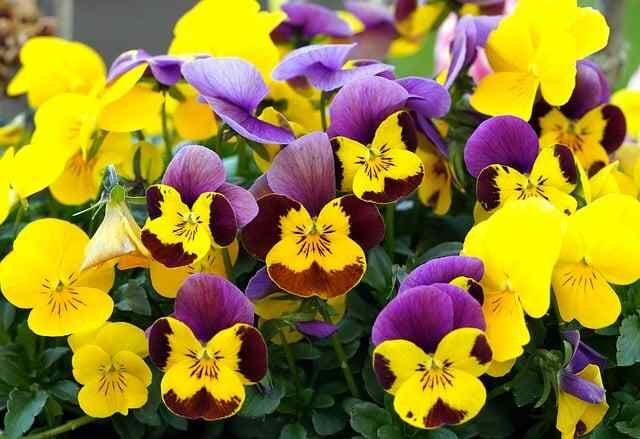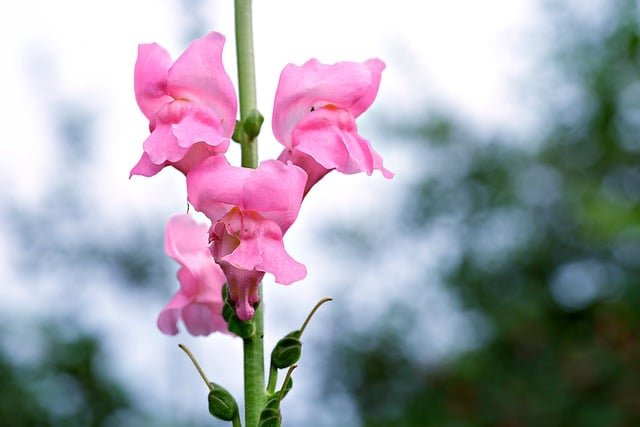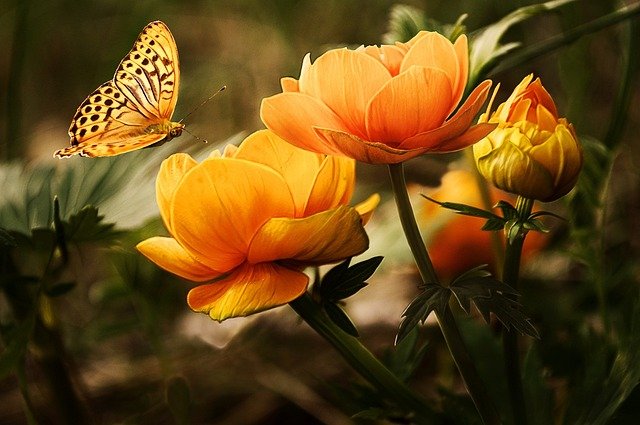Your vegetable garden needs more flowers, and today I’m going to tell you the top flowers that I love to plant in the cool season in my garden so you can add them to your garden too.
I’m so thankful to hang out with you today and I want to show you how you can use flowers to make your vegetable garden so much more beautiful, so much more productive, and actually so much healthier just by adding some color and some beauty.
So let’s talk about it. I will talk about eight different types of plants, and we graduate up one plant at a time to learn how to garden even if you’ve never kept a plant alive before. When we’re gardening, especially if we’re creating a vegetable garden, a kitchen garden, then it feels like we’re fighting against nature, right? It can feel like so many things are going wrong in the garden. And we are just constantly battling pests and disease and the garden evaporating, running out of water, and things stunted and not growing well, and it just puts us almost always on the defense in the garden. But my perspective on the garden is to stay on the offense. I call it stay on the offense. And the way we do that is by working with nature instead of feeling like we’re fighting against it. A key way that we work with nature with our plants and with our vegetable garden is with flowers. So let me explain what I mean.
When you put flowers in your kitchen garden, in your vegetable garden, I love to put these flowers around the outside borders of my raised beds. So I don’t like to put them in the middle of the raised beds. I find often they’re gonna get lost in between the tall plants, the vining plants, the tomatoes and peppers. When I’ve got all those big tall plants in the middle of the bed, the flowers end up losing light, losing space, and just losing out. So instead, I take my flowers and put them around the perimeters of my raised beds. This ensures the flowers have plenty of room to grow, they get plenty of sunlight, and they do their job in terms of protecting the garden. So that’s the first thing to remember when you’re picking your flowers for your kitchen garden, is let these flowers go on the outside of your beds, not on the interior. This helps also with the growth of these flowers.
You’re going to find a lot of these have a vining growing property or kind of a climbing or like a draping type growth. And so flowers that have that kind of growth are going to do great on the outside of the beds because they’ll simply have their root structure right inside your raised bed, and then they’ll be able to just flow along the outside of the bed and not take up any more space on the interior of the bed, where that growing space is so high property value, right? You want to really treasure and make sure you take care of every little square inch you’ve got inside your raised beds, so you want the flowers to flow on the outside of the bed and then save that interior space for your vegetables, your fruiting plants that need that really deep soil in your raised beds and need more space to spread out.
So we’re going to plant the flowers all around the outside of the raised bed and they’re going to serve several different purposes for us. So the first thing that these flowers do is they attract pollinators. So in the the cool season, we really don’t have that many plants that need pollination. Mostly, I can think of our fruiting plants like sugar snap peas or fava beans or snow peas. Those are the ones that go from flower to fruit. And so those may need a little bit of help with pollination, but just in general, we all know we need to be providing food for bees and butterflies, right? That’s like commonly known. We’re all #savethebees, #savethemonarchs. And so just by providing these flowers, you’re giving extra early food for pollinators. Because remember, this is in the cool season. So this is the very start of the growing period in the garden. And then again, in the fall, right before we head into winter, once again. So that’s the most important part, I would say, in terms of nature,is just providing a haven, providing a place for these creatures that we know need more food, need more habitat, and need a place to just live and survive. So by adding these flowers to your garden space that aren’t grown with pesticides or fungicides or herbicides or fertilizers, then you’re giving this nice natural food to the pollinators that’s so critical for their survival and critical for ours too. Plus bonus, they’re going to help make your fruiting plants more fruitful. So you’ll get more peas, more fava beans, all that good stuff. So that’s number one, why we add flowers.
The second reason why we want to add flowers to our kitchen garden is for pest protection. So a lot of these flowers are what we call trap crops. They will attract pests to themselves. Well, they’re really… there’s two different, they play two different roles. So some flowers are actually going to attract pests. And you’re thinking, “Uh, why would I want to plant some flowers in my garden that are going to literally bring pests to my garden?” Well, here’s like the headline: Pests are coming to your garden regardless, all right? They’re going to be coming to your garden. If you’re not using pesticides and all that bad stuff, then they’re going to be in your garden anyway. So our goal then is to distract them. That is the name of the game, is distracting those pests from the plants that you want to protect and enjoy and eat the most. So we use what we call trap crops, flowers that pull in the pests that attract the pests, but don’t end up being something that could be ruined or killed by those pests. So two examples are calendula and nasturtium Both of those flowers will attract some of the pests that might otherwise attack your leafy greens, and they’ll just hold those pests right there on the flowers and the stems, and hopefully distract them long enough so that they leave your cabbage and your kale and your lettuce for you to harvest instead. So that’s one way that flowers help with pests. The second way is they can actually repel pests. So some of these flowers are gonna put off certain scents and in certain smells that give pests like the warning sign that they don’t wanna come near this part of your landscape, this part of your yard. So you wanna go with more naturally fragrant flowers in your garden. Those are going to throw off pests, maybe repel pests and keep those pests from coming close to your vegetables. This is another reason why I love putting the flowers around the perimeter of the garden space because especially if these are crawling insects, then they’re going to have to pass by these very smelly, fragrant flowers before they head to the things they’re wanting to eat like my lettuces and cabbages and all my greens. So flowers have two roles when it comes to taking care of pests for us. One, they distract them, give them lots of things to eat and to enjoy so that they don’t mess with our food. Or two, they repel them. They keep them away from that garden space because of their smells that turn off the pests so they don’t come and eat all our good food.
So first, flowers are so good for the garden because they bring in pollinators and provide for pollinators. Second, they’re so good for the garden because they deal with pests so that we don’t have to. Finally, they just add to the beauty and the color of the garden. My team and I were just talking recently about our favorite season in the garden last year and hands down all of us love the spring garden the most. And it’s because the flowers were so vibrant. I had all these snapdragons and pansies and violas. The garden was packed with color and it just made the space so perfect, so enjoyable, and so pleasing to the eye and made you want to go into the garden, and that’s the name of the game when it comes to being successful as a gardener. So when you’re thinking about the flowers for your garden, you want to also be thinking about colors that you love, colors that compliment your house or your landscape or even just the garden that you’ve set up. You want to use colors that speak to you and that are really attractive to you so that you go out in the garden more, you enjoy it more, you’re more proud of it. We have found over the years that people who see their garden as beautiful, people who admire the beauty of their garden, they’re the most successful gardeners because they’re just drawn to being in a place that they love and that they think is so pretty and so flowers definitely do that. So if you don’t do it for any other reason just do it to make your garden more beautiful so that you go out there more often.
All right So those are the three reasons we add flowers to our garden spaces. It is the way that we work with nature and that we also just create super stunning gardens.
So some of my favorite flowers to add to the garden in the cool season are first pansies. Pansies are so easy to grow along the edges of your bed. They come very small. No pesticides, no fertilizers. And I just plant these pansies right alongside the edge of the bed. As they grow and get more mature, they’ll eventually drape over the sides of the bed. It’s so beautiful and colorful. There’s all different kinds of colors you can get. This time got purple, yellow, and white. And they do so well and they’ll last all the way until it gets pretty warm at the start of the summer.

The next plant is snapdragons. So snapdragons generally I’d want to buy before they get to this point when they’re starting to flower. You really want to buy it just when it’s starting to bud. And snapdragons are such good food for bees. Last year I probably had 18 red snapdragon plants in my garden, and I’m not exaggerating when I say every time I went out to the garden there were little bees all hidden in between each and every one of the petals. It was magical. So if you want to give some good food to the bees you’ve got to plant some snapdragons. Now you can grow these from seed, but this is an advanced gardening skill, and you’d want to have started these indoors about two months before these are gonna go out into the garden. So we’re talking in my area, I would need to start these even before the end of the year. So it’s like a December planting indoors in order to have it ready for February planting outside. So two months before they go into the garden, they need to be started indoors. Or I find it, honestly, this is one of the things that’s totally worth the investment for me to go to a grower that I trust, that I love the way that they grow their plants, buy high-quality plants from them. And I don’t have the space to be starting, you know, rows and rows and rows of flowers at my house. So it’s totally worth it for me to invest in them and let them grow them for me. Now here are a few you could start from seed yourself and this one first one is calendula. Calendula is a super easy flower to start from seed. It is frost-hardy, and it can grow right alongside the edge of your bed as well. It’s going to drape over and this is the one that I mentioned is a great trap crop. It will attract like aphids and pests that otherwise would hit your greens. They’re going to go to the calendula instead. Calendula is an herb so you can use it for teas and tinctures and oils, and it’s just a beautiful flower but it’s got so many purposes in the garden. It is like a must-grow. The other one that’s fun to grow from seed, the seeds are tiny, is chamomile. If you can find this from a grower you totally, it’s totally worth buying but this is also frost-hardy and you can generally grow these simply by scattering the seed. They’re going to be pretty easy to start from seed. You can start these indoors, but again, just like the pansies, these need more time indoors.

So you could just scatter these right at the start of the spring season or even a little bit sooner and they’ll come up from seed for you. The other plant I would say is totally worth purchasing is violas. Some people call it violas. I’m not sure my daughter played the violas so I’m going with that but very similar to pansies, similar colors, the flowers are a little bit smaller, but same growth habit, same benefits to the garden. So I usually like to do a mix of violas, pansies, snapdragons for the plants that I buy and then I’ll add in some chamomile and calendula from seed as well.

So there you have it. Those are the flowers I love to add to the garden for the cool season, and now you know the reason why. I would never, ever, ever, ever, ever try to grow a vegetable garden without flowers in it. Otherwise, you’re creating this big buffet for all the wildlife to come and enjoy. Flowers interrupt the pests. They repel the pests, and they keep the pest from heading into your garden. Plus, they attract all the good guys to come and head into your garden and help you grow more and more food all season long.



